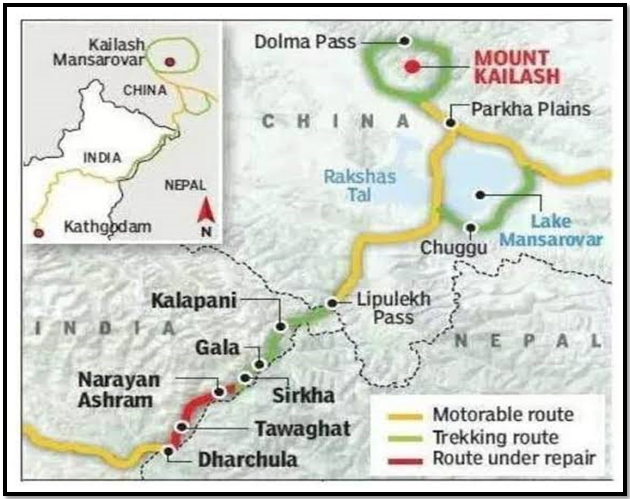NEPAL-INDIA RELATIONS RESET
Syllabus:
GS 3:
- India and its Neighbourhood- Relations.
- Effect of Policies and Politics of Developed and Developing Countries on India’s interests.
Focus:
Nepal-India relations are in the spotlight as both nations seek to mend ties following years of diplomatic and economic tensions. With recent changes in leadership, there’s a renewed opportunity to establish a more stable and positive relationship, focusing on mutual respect and balanced economic cooperation.
Source: BHP
Recent History and Current Context
- Diplomatic Decline: Relations between India and Nepal have been strained since 2015 when Narendra Modi and Khadga Prasad Oli were both Prime Ministers. This period marked a significant downturn in the traditionally close ties between the two nations, driven by political and economic disputes.
- New Opportunities: With Indian PM’s third term and Nepal PM’s unique collaboration with the Nepali Congress, there’s a renewed chance to improve the relationship. Both leaders now have the opportunity to reset and strengthen bilateral relations, moving towards a more stable and positive engagement.
- Constitutional Controversy: Tensions began with Nepal’s adoption of a new Constitution in 2015, which India wanted reworked. New Delhi’s dissatisfaction with the unamended Constitution led to significant political friction.
- Economic Blockade: New Delhi imposed a six-month blockade on Nepal, generating long-lasting resentment. This blockade, blamed on Madhesi activists by India, severely impacted Nepal’s economy and created widespread animosity towards India.
- Nepal-China Agreements: In response to the blockade, Oli signed multiple agreements with China, expanding ties in trade, transit, power, and transport. This shift towards Beijing was seen as a strategic move to reduce dependence on India.
- Historical Claims: Oli’s remarks on Ayodhya being in Nepal and his call for India’s national motto change further strained relations. Additionally, Nepal’s revised political map including disputed territories intensified the diplomatic standoff.
India’s Involvement in Nepal
- Political Interference: India has been deeply involved in Nepali governance, often breaching the principle of non-interference. This involvement has been perceived as overreach and has caused significant friction.
- Hindutva Influence: The RSS and BJP have tried to shape Nepal’s political landscape to mirror India’s, causing friction. Their efforts to promote Hindutva ideals have been met with resistance in Nepal.
- Economic Coercion: India’s blockade and economic pressures have been seen as attempts to control Nepal’s political decisions. Such actions have fueled anti-India sentiments among Nepali citizens and leaders.
- Security Concerns: India’s involvement has often been justified by geopolitical and national security considerations. However, this has led to a perception of India as an overbearing neighbor.
- Local Resistance: Despite India’s efforts, Nepal has resisted external control, seeking to maintain its sovereignty. The country’s leadership has consistently pushed back against perceived Indian dominance.
- Need for Policy Change: A hands-off approach could lead to a stable and economically energized Nepal, benefiting both nations. Respecting Nepal’s autonomy could enhance bilateral relations and regional stability.
| Major Areas of Cooperation Between India and Nepal
About
Treaty of Peace and Friendship (1950). Economic Cooperation
Defence Cooperation
Cultural Cooperation
Water Sharing
Connectivity
|
Power Dynamics and Diplomacy
- Modi’s Third Term: Speculation is high in Kathmandu about Modi’s approach, given his legacy of the blockade and Hindutva activism. His third term presents both opportunities and challenges for Nepal-India relations.
- Foreign Policy Adjustments: Modi’s ‘Neighbourhood First’ initiative requires policy corrections, starting with Nepal. Revisiting and realigning this policy could improve ties with Nepal and other neighboring countries.
- Historical Context: Indian exceptionalism in Nepal dates back to Nehru’s era, highlighting the need for a change in approach. Historical patterns of interference and control need to be reassessed.
- Principle of Non-Interference: Adhering to Panchsheel’s non-interference principle can stabilize Nepal’s politics and economy. Respecting Nepal’s sovereignty could foster a more balanced relationship.
- Economic Contributions: Nepal is a significant remittance sender to India, aiding livelihoods in India’s poorest regions. This economic interdependence highlights the mutual benefits of a strong bilateral relationship.
- Mutual Benefits: A stable and prosperous Nepal supports India’s national security and economic interests. Collaborative efforts can enhance regional stability and economic growth.
Challenges in Bilateral Relations
- Political Erosion: Nepal’s ability to negotiate on equal terms with India has weakened due to internal political chaos. This has undermined Nepal’s position in bilateral discussions.
- Weak Leadership: Nepali leaders, including Pushpa Kamal Dahal (‘Prachanda’), have often avoided confronting India on crucial issues. Their reluctance to address contentious matters has impeded progress.
- Unresolved Issues: Key bilateral matters, such as air routes, territorial disputes, and the EPG report, remain unaddressed. Resolving these issues is crucial for improving relations.
- Economic Agreements: Dahal’s agreements with India, favoring Indian interests, have faced domestic criticism. These deals have been viewed as compromising Nepal’s sovereignty.
- Diplomatic Missteps: Dahal’s attempts to please the RSS and concessions to India have weakened Nepal’s negotiating position. His actions have been criticized for undermining Nepal’s interests.
- Systemic Limitations: India’s influence in Nepal is constrained, necessitating a balanced and respectful approach to diplomacy. Recognizing the limitations of coercive tactics could lead to more productive engagement.
Path Forward for Nepal-India Relations
- Assertive Leadership: Oli must adopt a more confident stance, advocating for Nepal’s interests and regional cooperation. Strong leadership can help navigate complex bilateral issues.
- SAARC Revival: Convincing India of the importance of reviving SAARC can strengthen South Asian cooperation. Regional collaboration can enhance economic and political stability.
- Balanced Relations: Nepal’s friendship with China is non-negotiable but not at India’s expense, necessitating balanced diplomacy. Managing relations with both neighbors is key to regional stability.
- Economic Independence: Nepal seeks to assert its economic independence, particularly in hydropower and infrastructure projects. Developing independent economic policies can reduce external dependencies.
- Equal Partnership: The implementation of the EPG report can elevate bilateral relations to a transparent and equal partnership. This report outlines steps for a more balanced and cooperative relationship.
- Policy Reflection: India must reflect on the failures of its interference policy and adopt a more respectful and cooperative approach. Learning from past mistakes can lead to a more constructive engagement.
Vision for a Peaceful South Asia
- Inherent Cordiality: Nepal’s default stance is friendly towards India, despite New Delhi’s strategic insecurities. Recognizing this inherent goodwill can foster better relations.
- Geostrategic Misunderstandings: India’s paranoia about Nepal’s relations with China fuels unnecessary geopolitical tensions. Understanding the benign nature of Nepal’s foreign policy can reduce these tensions.
- Connectivity Potential: Nepal has the potential to be a connectivity gateway to China, benefiting regional trade and relations. Enhancing infrastructure and trade links can boost regional economies.
- Military Economics: Nepal’s role as a benign buffer reduces India’s military expenditure, highlighting mutual benefits. A stable Nepal can contribute to regional security.
- Border Misconceptions: Misunderstandings about the open Nepal-India border need to be addressed for mutual security. Clear communication and cooperation on border issues can improve security.
- Cultural Outreach: Nepal must actively engage with India to correct misconceptions and promote mutual understanding. Cultural diplomacy can strengthen people-to-people ties and improve bilateral relations.
- Fraternal Relationship: Moving from a ‘big brother’ to a ‘brotherly’ relationship can foster greater cooperation and respect between the two nations. Emphasizing equality and mutual respect can enhance bilateral ties.
Conclusion
Rebuilding Nepal-India relations requires mutual respect, balanced diplomacy, and addressing unresolved issues. Both nations must prioritize transparent and equal partnerships, recognizing the importance of economic interdependence and regional stability. Effective leadership and policy adjustments can pave the way for a more harmonious and cooperative future.
Source:The Hindu
Mains Practice Question:
Discuss the recent historical context of Nepal-India relations and suggest measures to enhance bilateral cooperation. How can both nations balance their interests while ensuring regional stability and economic growth?
Associated Article:





